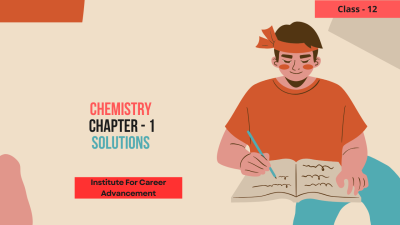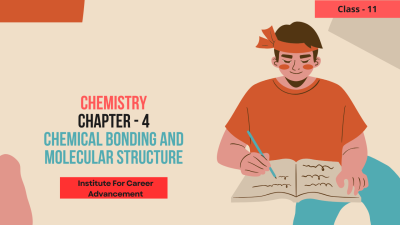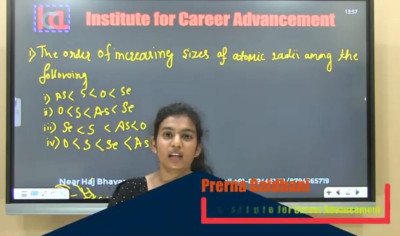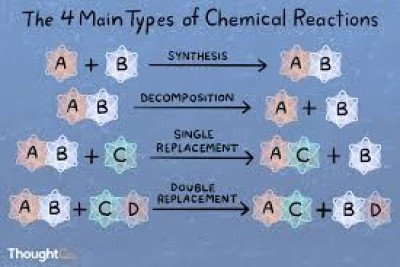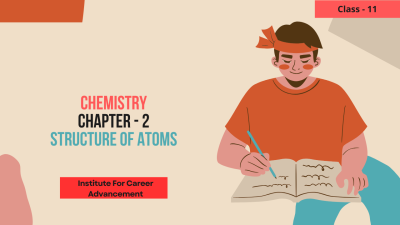Course description
In the captivating world of chemistry, solutions play a central role. This Class 12 course delves into the fascinating realm of mixtures where one substance dissolves in another, forming a seemingly uniform phase.
The Key Players: Solvents & Solutes
- Unveiling the Solvents: Get ready to meet the dissolving medium – the solvent. This course explores the characteristics of solvents, typically liquids, that have the ability to dissolve other substances. You'll learn about factors influencing solvent properties, such as polarity, which plays a crucial role in the dissolving process.
- The Stars of the Show: Solutes: Solutes are the substances that take center stage by dissolving in the solvent. This course explores different types of solutes and the factors affecting their solubility. Understanding the interplay between solvent and solute properties is essential for predicting how readily a substance will dissolve.
Concentration: The Art of Measurement
- Expressing Concentration: How much solute is dissolved in a given amount of solvent? This course equips you with the tools to express concentration effectively. You'll learn about various concentration units, including mass percentage, volume percentage, molarity (moles of solute per liter of solution), and molality (moles of solute per kilogram of solvent). You'll not only understand how to calculate these concentrations but also grasp their significance in interpreting the properties of solutions.
Colligative Properties: A Unique Fingerprint
Solutions exhibit unique properties that depend on the number of dissolved solute particles, not their identity. This course introduces you to fascinating colligative properties, including:
- Boiling Point Elevation: The presence of solute particles raises the boiling point of a solution compared to the pure solvent.
- Freezing Point Depression: Solutes lower the freezing point of a solution, making it more difficult for it to solidify.
- Osmotic Pressure: This property arises due to the tendency of solvent molecules to move across a semipermeable membrane from a low solute concentration to a high solute concentration.
Understanding colligative properties has numerous applications, from explaining how antifreeze works to measuring the concentration of unknown solutions.
A World of Solutions: Beyond the Basics
Not all solutions are created equal! This course explores the diverse world of solutions based on the physical state of the solute and solvent:
- Solid Solutions: Alloys, like steel, are examples of solid solutions where a solid solute dissolves in a solid solvent to form a uniform mixture.
- Liquid Solutions: The most common type, explored throughout the course, involves a liquid solvent dissolving a solid, liquid, or gas solute.
- Gaseous Solutions: Air is a prime example! This course explores how gases can dissolve in liquids, with applications in areas like carbonated beverages and scuba diving.
By understanding the different types of solutions, you gain a broader perspective on this fundamental chemical concept.
Beyond the Course: A Foundation for Further Exploration
The knowledge gained in this Solutions course forms a strong foundation for various scientific disciplines:
- Physical Chemistry: Understanding solutions is crucial for studying thermodynamics, kinetics, and other areas of physical chemistry.
- Analytical Chemistry: Solution preparation, concentration analysis, and colligative properties are essential tools in analytical techniques.
- Environmental Chemistry: Solutions play a vital role in understanding environmental phenomena like pollution and water treatment.
রসায়নের চিত্তাকর্ষক জগতে, সমাধানগুলি একটি কেন্দ্রীয় ভূমিকা পালন করে। এই দ্বাদশ শ্রেণির কোর্সটি মিশ্রণের আকর্ষণীয় ক্ষেত্রের মধ্যে প্রবেশ করে যেখানে একটি পদার্থ অন্যটিতে দ্রবীভূত হয়, যা আপাতদৃষ্টিতে অভিন্ন পর্যায় গঠন করে।
মূল খেলোয়াড়ঃ দ্রাবক ও দ্রবণ
দ্রাবকগুলি উন্মোচন করাঃ দ্রবীভূত মাধ্যম-দ্রাবকের সঙ্গে মিলিত হওয়ার জন্য প্রস্তুত হোন। এই কোর্সটি দ্রাবকগুলির বৈশিষ্ট্যগুলি অন্বেষণ করে, সাধারণত তরল, যা অন্যান্য পদার্থ দ্রবীভূত করার ক্ষমতা রাখে। আপনি দ্রাবক বৈশিষ্ট্যগুলিকে প্রভাবিত করে এমন কারণগুলি সম্পর্কে শিখবেন, যেমন মেরুতা, যা দ্রবীভূতকরণ প্রক্রিয়ায় গুরুত্বপূর্ণ ভূমিকা পালন করে।
দ্য স্টার অফ দ্য শোঃ সমাধানঃ দ্রাবক হল সেই পদার্থ যা দ্রাবকের মধ্যে দ্রবীভূত হয়ে কেন্দ্রবিন্দুতে চলে যায়। এই কোর্সটি বিভিন্ন ধরনের দ্রবণ এবং তাদের দ্রবণীয়তাকে প্রভাবিত করে এমন কারণগুলি অন্বেষণ করে। একটি পদার্থ কত সহজেই দ্রবীভূত হবে তা অনুমান করার জন্য দ্রাবক এবং দ্রাবক বৈশিষ্ট্যের মধ্যে পারস্পরিক ক্রিয়া বোঝা অপরিহার্য।
মনোযোগঃ পরিমাপের শিল্প
ঘনত্ব প্রকাশঃ একটি নির্দিষ্ট পরিমাণ দ্রাবকে কত দ্রবণ দ্রবীভূত হয়? এই কোর্সটি আপনাকে কার্যকরভাবে মনোনিবেশ প্রকাশ করার সরঞ্জাম দিয়ে সজ্জিত করে। আপনি ভর শতাংশ, আয়তনের শতাংশ, মোলারিটি (প্রতি লিটার দ্রবণে দ্রবণের মোল) এবং মোলালিটি সহ বিভিন্ন ঘনত্ব ইউনিট সম্পর্কে শিখবেন। (moles of solute per kilogram of solvent). আপনি কেবল এই ঘনত্বগুলি কীভাবে গণনা করবেন তা বুঝতে পারবেন না, তবে সমাধানগুলির বৈশিষ্ট্যগুলি ব্যাখ্যায় তাদের তাৎপর্যও বুঝতে পারবেন।
সমন্বিত বৈশিষ্ট্যঃ একটি অনন্য আঙ্গুলের ছাপ
দ্রবণগুলি অনন্য বৈশিষ্ট্য প্রদর্শন করে যা দ্রবীভূত দ্রবণীয় কণাগুলির সংখ্যার উপর নির্ভর করে, তাদের পরিচয়ের উপর নয়। এই কোর্সটি আপনাকে আকর্ষণীয় কোলিগেটিভ বৈশিষ্ট্যগুলির সাথে পরিচয় করিয়ে দেয়, যার মধ্যে রয়েছেঃ
বয়লিং পয়েন্ট এলিভেশনঃ দ্রবণ কণার উপস্থিতি বিশুদ্ধ দ্রাবকের তুলনায় দ্রবণের বয়লিং পয়েন্ট বাড়ায়।
হিমায়িত বিন্দু বিষণ্ণতাঃ দ্রবণগুলি একটি দ্রবণের হিমায়িত বিন্দুকে কমিয়ে দেয়, যার ফলে এটি দৃঢ় করা আরও কঠিন হয়ে পড়ে।
অসমোটিক চাপঃ এই বৈশিষ্ট্যটি দ্রাবক অণুগুলির একটি অর্ধ-ব্যাপ্তিযোগ্য ঝিল্লি জুড়ে কম দ্রবণ ঘনত্ব থেকে উচ্চ দ্রবণ ঘনত্বে যাওয়ার প্রবণতার কারণে উদ্ভূত হয়।
অ্যান্টিফ্রিজ কীভাবে কাজ করে তা ব্যাখ্যা করা থেকে শুরু করে অজানা সমাধানের ঘনত্ব পরিমাপ করা পর্যন্ত কোলিগেটিভ বৈশিষ্ট্যগুলি বোঝার অসংখ্য প্রয়োগ রয়েছে।
সমাধানের একটি বিশ্বঃ মূল বিষয়গুলির বাইরে
সব সমাধান সমানভাবে তৈরি করা হয় না! এই কোর্সটি দ্রবণ এবং দ্রাবকের শারীরিক অবস্থার উপর ভিত্তি করে সমাধানের বৈচিত্র্যময় বিশ্বের অন্বেষণ করেঃ
কঠিন দ্রবণঃ ইস্পাতের মতো মিশ্র ধাতুও কঠিন দ্রবণের উদাহরণ যেখানে একটি কঠিন দ্রবণ একটি কঠিন দ্রাবকে দ্রবীভূত করে একটি অভিন্ন মিশ্রণ তৈরি করে।
তরল দ্রবণঃ কোর্স জুড়ে অন্বেষণ করা সবচেয়ে সাধারণ প্রকারের মধ্যে একটি তরল দ্রাবক একটি কঠিন, তরল বা গ্যাস দ্রবণ দ্রবীভূত করে।
বায়বীয় দ্রবণঃ বায়ু একটি প্রধান উদাহরণ! কার্বনেটেড পানীয় এবং স্কুবা ডাইভিংয়ের মতো ক্ষেত্রে প্রয়োগ সহ গ্যাসগুলি কীভাবে তরলে দ্রবীভূত হতে পারে তা এই কোর্সটি অন্বেষণ করে।
বিভিন্ন ধরনের সমাধান বোঝার মাধ্যমে, আপনি এই মৌলিক রাসায়নিক ধারণার উপর একটি বিস্তৃত দৃষ্টিভঙ্গি অর্জন করতে পারেন।
কোর্সের বাইরেঃ আরও অনুসন্ধানের জন্য একটি ভিত্তি
এই সলিউশন কোর্সে প্রাপ্ত জ্ঞান বিভিন্ন বৈজ্ঞানিক শাখার জন্য একটি শক্তিশালী ভিত্তি গঠন করেঃ
ভৌত রসায়নঃ তাপগতিবিদ্যা, গতিবিদ্যা এবং ভৌত রসায়নের অন্যান্য ক্ষেত্র অধ্যয়নের জন্য সমাধানগুলি বোঝা অত্যন্ত গুরুত্বপূর্ণ।
বিশ্লেষণাত্মক রসায়নঃ সমাধান প্রস্তুতি, ঘনত্ব বিশ্লেষণ এবং সংযোগমূলক বৈশিষ্ট্যগুলি বিশ্লেষণাত্মক কৌশলগুলির প্রয়োজনীয় সরঞ্জাম।
পরিবেশ রসায়নঃ দূষণ এবং জল পরিশোধন-এর মতো পরিবেশগত ঘটনাগুলি বোঝার ক্ষেত্রে সমাধানগুলি গুরুত্বপূর্ণ ভূমিকা পালন করে।

